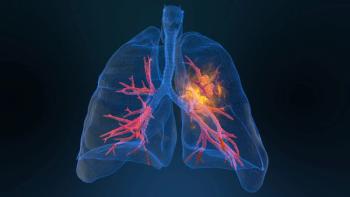
Oncology NEWS International
- Oncology NEWS International Vol 10 No 5
- Volume 10
- Issue 5
Gemcitabine-Oxaliplatin Used in Advanced Lung, Ovarian Cancer
NEW YORK-In a phase I/II study combining gemcitabine (Gemzar) and oxaliplatin, French investigators saw a 47% objective response rate among evaluable patients with advanced non-small-cell lung cancer (NSCLC).
NEW YORKIn a phase I/II study combining gemcitabine (Gemzar) and oxaliplatin, French investigators saw a 47% objective response rate among evaluable patients with advanced non-small-cell lung cancer (NSCLC).
Thierry Le Chevalier, MD, chief, Department of Medicine, Institut Gustave-Roussy, Villejuif, reported at the Chemotherapy Foundation Symposium XVIII that 13 of the 28 evaluable patients with stage III/IV NSCLC had a major response and 8 others had stable disease. Disease progression occurred in 7 patients. Of the 9 patients with ovarian cancer, 3 showed an objective response.
The outpatient study tested six different dosage combinations in 35 lung cancer patients and 9 with ovarian carcinoma. The dosages ranged from 800 mg/m2 gemcitabine and 70 mg/m2 oxaliplatin every 2 weeks to 1,500 mg/m2 gemcitabine and 85 mg/m2 oxaliplatin every 2 weeks. The highest level tested turned out to be the maximum tolerated dose and is recommended for further study.
On days 1 and 14 of the 28-day treatment cycles, patients received a 30-minute infusion of gemcitabine followed by a 2-hour infusion of oxaliplatin. Treatment can be completed in 3 hours, Dr. Le Chevalier noted. The schedule was based on laboratory studies that had shown better in vitro activity of the combination when gemcitabine was given before oxaliplatin, he explained. In preclinical studies, he noted, oxaliplatin showed a broader spectrum of activity than cisplatin (Platinol), which has long been used in doublet therapy in NSCLC.
Both gemcitabine and oxaliplatin have clinical activity against lung and ovarian cancer. "Their mechanism of action and resistance are distinct," he said. "In the preclinical studies, we showed a synergistic activity between gemcitabine and oxaliplatin and at least an equal or better synergistic effect of the gemcitabine-oxaliplatin combination, compared with the gemcitabine-cisplatin combination."
Toxicity Results
All lung cancer patients were evaluable for acute toxicity and 29 for chronic toxicity, he said. There was no dose-limiting toxicity at the time of the first cycle. Nonhematologic toxicity consisted mainly of nausea and vomiting in a small proportion of patients and asthenia in 18% of all cycles, he said. Transient grade 3 asthenia, observed in 2% of the cycles, was responsible for treatment delay in one patient. One patient experienced a grade 2 flu-like syndrome.
Hematologic toxicity was not a major occurrence. "Even at the highest dose," Dr. Le Chevalier said, "most patients didn’t experience a major neutropenia." Grade 3 neutropenia, he reported, occurred in only 3 of 55 cycles of treatment at the highest dose levels. Grade 3 thrombocytopenia was seen in one patient.
The toxicity profile in the ovarian carcinoma group was similar to that of the lung cancer patients.
At the three highest doses, he said, "we saw several grade 2-3 neurotoxicities; some of those patients are still under treatment, and the assessment for that is not finished." Of the five patients who received five cycles, four developed grade 3 neurotoxicity and were withdrawn from the study for that reason.
Treatment was delayed in 7 of the total 125 cycles in the lung cancer group. In six instances, the delay was caused by grade 1, 2, or 3 thrombocytopenia, and in one case the reason was transient asthenia. "Most patients," Dr. Le Chevalier observed, "could get the treatment right at the time set by the protocol."
Gemcitabine-oxaliplatin is generally well tolerated, Dr. Le Chevalier concluded. "The complete and partial responses seen with this combination suggest it could be compared to the classical gemcitabine-cisplatin doublet in advanced NSCLC," he said.
Articles in this issue
over 24 years ago
Adjuvant Chemo Dose Reductions Frequent in Breast Cancerover 24 years ago
Women May Be at Greater Risk for Undertreatment of Cancer Painover 24 years ago
Umbilical Cord Blood in Adult Leukemia Patientsover 24 years ago
Irinotecan Results Continue to Be Encouraging in Colorectal Cancerover 24 years ago
Irinotecan Active in Pediatric Cancersover 24 years ago
Ultrasound Contrast Agents Help Diagnose Prostate Cancerover 24 years ago
Optimal Use of Irinotecan Still to be Determinedover 24 years ago
Groups Urge Federal Action Against Eclipse Cigarettesover 24 years ago
Potential Advantages of Oral Irinotecan Defined in Phase I StudiesNewsletter
Stay up to date on recent advances in the multidisciplinary approach to cancer.





















































































